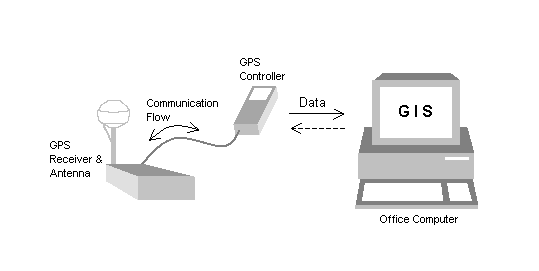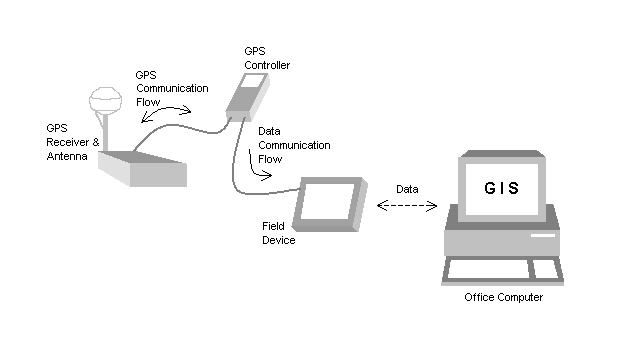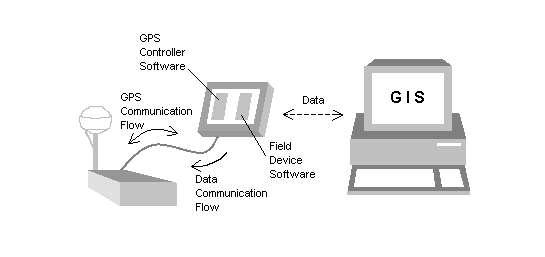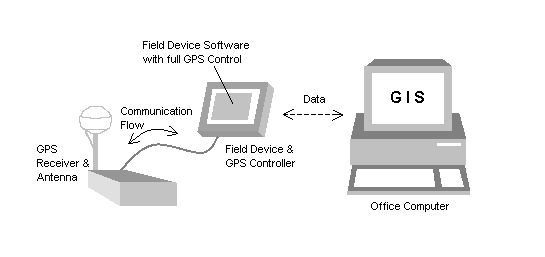
Andrew Harrington
GPS has long been considered a technology that compliments GIS operations. The integration of GPS technology into GIS activities can be achieved through a variety of means. These range from the transfer of data from GPS systems, for the building of new database, though to the complete integration of GPS technology into existing GIS systems, to conduct spatial analysis directly in the field. This paper describes the numerous ways that GPS can be integrated with GIS, providing a particular emphasis on the integration of GPS technology with MapObjects through the use of component technologies.
Global positioning system (GPS) technology has complimented geographic information systems (GISs) for a number of years and is now well understood and accepted by the GIS community. The primary focus of GPS within the GIS arena has traditionally been based around GPS systems that collect, store and transfer data from a field system to an office-based GIS. With current developments in field computers (especially related to lightweight and low cost devices that operate Microsoft's Windows CE operating system) there is a strong desire to take GIS directly into the field. This increased interest in field-GIS has a corresponding interest in the application of GPS within GIS.
There are three basic ways that GPS technology can interact with or be integrated into GIS. The level of integration associated with these vary from a 'disparate' connection, whereby data is transferred between a GPS system and a GIS system, through to a very 'tight' level of integration, whereby GPS technology is totally embedded directly within GIS application software. GIS/GPS integration can be categorized into the following three categories:
The appropriateness of each method is dependent upon the requirements that a user has for field-based operations, the level of dependence the user has on GPS and, to a large extent, the availability of a complete system to meet the specific needs that the user has for a system.
To date, the most common method of integrating GPS into GIS has been through a data-focused method of integration. (Although the term 'interaction' is probably a more appropriate term than 'integration'.) Data-focused integration, as depicted by Figure 1., utilizes a complete, self-contained GPS system that has data collection and storage capability for use in the field. Data that is collected in the field is later transferred to an office PC for processing and eventual export to an enterprise GIS that resides within an organization. Historically, data-focused systems have concentrated on a one-way data flow whereby data is transferred from the GPS product to the GIS database. GPS field products are now emerging, however, that allow data from the GIS to be uploaded as well, so existing data can be taken easily back to the field for data update and maintenance purposes.

Figure 1. Conceptual view of data-focused integration
Self-contained GPS systems used in this manner are complete in themselves and generally developed by large GPS manufacturing organizations. The system consists of a GPS receiver, GPS antenna and a controlling device with data storage capability. Units can be either modular (as stylized in Figure 1.), fully integrated into one housing or a combination of the two. Historically, GPS systems have been rugged, to cater for harsh outdoor environments, with self-contained software that is optimized for limited storage, keyboards and screen real estate. These GPS systems are usually designed to meet the needs of most data collection or data maintenance professionals and are purchased as an off-the-shelf, turnkey system.
The primary advantage of utilizing a data-focused approach to GIS/GPS integration is that an end-user can operate the GPS system "out of the box" with little or no need for customization. For many GPS users, an off-the-shelf system will cater for most, if not all, of their needs for data collection and maintenance. A perceived downside is that there's often more functionality in the system than required, but the cost associated with a complete system is generally less expensive than costs associated with building a customized solution that is restricted to a specific application.
An example of a data-focused solution is Trimble Navigation's GeoExplorer® 3, for data collection and update, with GPS Pathfinder® Office, for data transfer and processing, and Esri's ArcInfo or ArcView products, for spatial analysis, query and archive.
Position-focused integration is, historically, the most common approach to GPS integration (as opposed to interaction). As depicted in Figures 2a. and 2b., position-focused integration generally consists of a complete GPS system supplying a separate field application with GPS derived data that is related solely to the computation of positions. Data from the GPS is commonly transmitted to the field device using the NMEA-0183 protocol, although this is not the only protocol used. NMEA-0183 is a strictly defined ASCII-based format that consists of several messages, which contain data that's packaged and sent to an external device. Data from the field device may be transferred to and from the enterprise GIS. This is not imperative however, as the field application may be a self contained GIS in its own right.

Figure 2a. Conceptual representation of position-focused integration using two field devices
Figure 2a. presents a good perspective on the components associated with position-focused integration. Position-focused integration essentially uses a GPS system, which could be the same as that used in data-focused integration, to provide data directly into an application running on the field device. In effect, the GPS system is treated as an external sensor by the application on the field device. The field device will usually provide data storage.

Figure 2b. Conceptual representation of position-focused integration using a single field device
With the advances in handheld field devices, it is becoming more common to find both the GPS control application and the field device application operating on the same device, as depicted in Figure 2b. It�s important to note though that the applications will be operated totally separate to one another. In general, one application is used to configure the GPS receiver and control the provision of position related data, while another application is used to store and use the data that is being sent to it. It's important to note that the data storage application has little or no control over the operation of the GPS equipment.
While systems that make use of position-focused integration can become cumbersome, from an equipment and ease of use perspective, and expensive they are very useful when GPS positioning is required on an infrequent basis. An organization, for example, may already have a complete GPS system for data collection purposes but may have another application that can make use of GPS from time to time. The ability to utilize the GPS system when GPS is useful makes good economic sense. The downside of losing a tight integration with the GPS receiver or carrying a cumbersome system may be an acceptable alternative to the expense required to fully customize a system.
An example of position-focused integration is seen through the use of Trimble Navigation's GPS Pathfinder Controller software to setup a GPS Pathfinder XRS receiver for use with Esri's ArcPad field-GIS product. While ArcPad is actually able to power on and connect to a GPS Pathfinder XRS receiver directly, it has not been designed to configure the GPS receiver directly. The Pathfinder Controller software acts as the controlling device for the GPS receiver, while ArcPad provides an interface that is designed well for image display and spatial query.
Technology-focused integration is a refinement of position-focused integration. As Figure 3 illustrates, control of the GPS hardware is achieved directly from a third party application, thus eliminating the need for a separate application or device to control the GPS receiver. Communication between the application and the GPS receiver has a two-way communication flow - as compared to the one-way flow associated with the secondary application and the GPS system in the position-focused approach. As with position-focused integration, it is optional for data to be transferred between the field device and the enterprise GIS. The transfer of data is dependant on the capabilities of the application on the field device.

Figure 3. Conceptual representation of technology-focused integration
This ability for a customized application to communicate directly with the GPS receiver enables GPS and GIS technologies to truly be integrated together in a seamless manner. In fact, the GPS technology is able to be totally embedded within a GIS application system to an extent that an end-user of the system will think that technologies from two different organizations actually came from one single source. Thus making a technology-focused application very similar to a data-focused system. The advantage though is that the full power of the GIS can also be taken directly into the field. The user-interface and functionality of the application can be totally designed around the needs of the user - resulting in powerful spatial analysis systems that are familiar and easy to use for the person who is going to use it most.
The reason that GPS receivers can be so tightly integrated is not new, but the current state of software technology has made a technology-focused integration approach more readily accessible to more people. Technology-focused integration requires a developer to be able to create programs using the raw (often proprietary) language (or protocol) of the GPS receiver. Proprietary protocols are generally in a binary format and can be very complex and complicated - at least for those who are not expert programmers. This has often meant that the development of customized GPS-based applications has been a costly exercise.
Now, however, through the use of component technologies (such as ActiveX components), it's significantly easier to integrate GIS and GPS components within the same programming code - or application. Software development products are emerging from within the GPS industry that takes the complex, but powerful, proprietary protocol of the GPS receiver and makes it simple to use and understand by 'wrapping' an ActiveX application programming interface (API) around the proprietary protocol. ActiveX components follow clearly defined rules for interacting with applications. Such standardized interaction allows the same control to be used in several different contexts. The applications are typically developed within Microsoft's Visual Basic, Visual C++ or VBA development environments, but ActiveX controls also operate in additional development environments.
As with the GPS industry, components are also available from GIS vendors, such as Esri's MapObjects ActiveX product. Because GPS and GIS ActiveX components adhere to a standard and commonly used API structure, the power that was once restricted to the large companies that develop GIS and GPS products is now readily available to all, enabling unique and powerful, user-specific solutions to be easily created.
The most significant advantage of a technology-focused integration approach is the flexibility it offers for both end-users and application developers alike. Although ActiveX has made it easy to develop applications using proprietary protocols, the programmer time required to develop customized applications can still make it prohibitively expensive. For that reason, technology-focused integration is best suited to very simple applications or applications that are complex in nature and cannot be catered for by an off-the-shelf system. For the majority of GIS professionals who make use of GPS, therefore, a data-focused integration approach often provides the most economical solution.
ActiveX components also exist for position-focused integration techniques, so it�s important to look closely at the component to ensure it provides the level of functionality that you expect. When looking for an appropriate GPS-based ActiveX component it's important to consider:
An example of technology-focused integration is the use of Trimble Navigation's Pathfinder Tools™ software development kit to integrate a GPS Pathfinder XRS receiver within a customized application that uses Esri's MapObjects product to visually display a map and carry out spatial analysis directly on a pen-based field computer.
There are numerous ways that GIS and GPS technology can (and already do) work well together. From complete off-the-shelf data collection and data maintenance systems, to help with the management of spatial features and attribute data, through to very flexible software development kits, to assist in the creation of unique and sophisticated field applications. The use of GPS within a GIS environment has already been well accepted and proven - especially for data collection and now data maintenance. The manner in which GPS is used with GIS is now wide and varied allowing users to determine the way GIS and GPS are used together to best meet their needs.
Harrington, Andrew, GPS/GIS Integration: GPS Can Play a Major Role in GIS Data Maintenance? GeoWorld, Daneilson, Todd (ed.), Vol.12 No.10, Arlington Heights: Adams Business Media, October 1999
Harrington, Andrew, GPS/GIS Integration: What is GPS/GIS Integration? GeoWorld, Daneilson, Todd (ed.), Vol.12 No.12, Arlington Heights: Adams Business Media, December 1999
Harrington, Andrew, GPS/GIS Integration: Consider the Differences Among GPS Integration Technologies? GeoWorld, Daneilson, Todd (ed.), Vol.13 No.2, Arlington Heights: Adams Business Media, February 2000
Andrew Harrington
Product Manager, Mapping & GIS Business Unit
Trimble Navigation Limited
645 N. Mary Avenue
Sunnyvale, CA 94086
Phone: (408) 481-8000
e-mail: Andrew_Harrington@Trimble.com